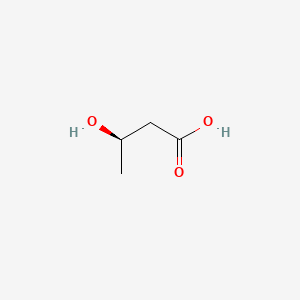| MeSH term | MeSH ID | Detail |
|---|---|---|
| Lipidoses | D008064 | 7 associated lipids |
| Hypopituitarism | D007018 | 7 associated lipids |
| Carcinoma, Non-Small-Cell Lung | D002289 | 72 associated lipids |
| Metabolic Syndrome | D024821 | 44 associated lipids |
| Amyotrophic Lateral Sclerosis | D000690 | 11 associated lipids |
| Diabetes, Gestational | D016640 | 8 associated lipids |
| Malnutrition | D044342 | 6 associated lipids |
| Insulin Resistance | D007333 | 99 associated lipids |
| Dehydration | D003681 | 11 associated lipids |
| Fatigue | D005221 | 10 associated lipids |
(r)-3-hydroxybutanoic acid
(r)-3-hydroxybutanoic acid is a lipid of Fatty Acyls (FA) class.
Cross Reference
There are no associated biomedical information in the current reference collection.
Current reference collection contains 2725 references associated with (r)-3-hydroxybutanoic acid in LipidPedia. Due to lack of full text of references or no associated biomedical terms are recognized in our current text-mining method, we cannot extract any biomedical terms related to diseases, pathways, locations, functions, genes, lipids, and animal models from the associated reference collection.
Users can download the reference list at the bottom of this page and read the reference manually to find out biomedical information.
Here are additional resources we collected from PubChem and MeSH for (r)-3-hydroxybutanoic acid
Possible diseases from mapped MeSH terms on references
We collected disease MeSH terms mapped to the references associated with (r)-3-hydroxybutanoic acid
PubChem Associated disorders and diseases
PubChem Biomolecular Interactions and Pathways
NCBI Entrez Crosslinks
All references with (r)-3-hydroxybutanoic acid
Download all related citations| Authors | Title | Published | Journal | PubMed Link |
|---|---|---|---|---|
| Monti LD et al. | Metabolic and endothelial effects of trimetazidine on forearm skeletal muscle in patients with type 2 diabetes and ischemic cardiomyopathy. | 2006 | Am. J. Physiol. Endocrinol. Metab. | pmid:16174656 |
| McGregor VP et al. | Elevated endogenous cortisol reduces autonomic neuroendocrine and symptom responses to subsequent hypoglycemia. | 2002 | Am. J. Physiol. Endocrinol. Metab. | pmid:11882496 |
| Hodson L et al. | Greater dietary fat oxidation in obese compared with lean men: an adaptive mechanism to prevent liver fat accumulation? | 2010 | Am. J. Physiol. Endocrinol. Metab. | pmid:20628024 |
| Chalhoub E et al. | A computer model of gluconeogenesis and lipid metabolism in the perfused liver. | 2007 | Am. J. Physiol. Endocrinol. Metab. | pmid:17911349 |
| Bielohuby M et al. | Induction of ketosis in rats fed low-carbohydrate, high-fat diets depends on the relative abundance of dietary fat and protein. | 2011 | Am. J. Physiol. Endocrinol. Metab. | pmid:20943751 |
| Dasarathy S et al. | Glycine and urea kinetics in nonalcoholic steatohepatitis in human: effect of intralipid infusion. | 2009 | Am. J. Physiol. Gastrointest. Liver Physiol. | pmid:19571235 |
| Cremin JD et al. | Glucose alleviates ammonia-induced inhibition of short-chain fatty acid metabolism in rat colonic epithelial cells. | 2003 | Am. J. Physiol. Gastrointest. Liver Physiol. | pmid:12637251 |
| Zou Z et al. | dl-3-Hydroxybutyrate administration prevents myocardial damage after coronary occlusion in rat hearts. | 2002 | Am. J. Physiol. Heart Circ. Physiol. | pmid:12384475 |
| Stanley WC et al. | beta-Hydroxybutyrate inhibits myocardial fatty acid oxidation in vivo independent of changes in malonyl-CoA content. | 2003 | Am. J. Physiol. Heart Circ. Physiol. | pmid:12969881 |
| Linke A et al. | Shift in metabolic substrate uptake by the heart during development of alloxan-induced diabetes. | 2003 | Am. J. Physiol. Heart Circ. Physiol. | pmid:12915387 |
| White RL and Wittenberg BA | Mitochondrial NAD(P)H, ADP, oxidative phosphorylation, and contraction in isolated heart cells. | 2000 | Am. J. Physiol. Heart Circ. Physiol. | pmid:11009472 |
| Bigrigg JK et al. | Carbohydrate refeeding after a high-fat diet rapidly reverses the adaptive increase in human skeletal muscle PDH kinase activity. | 2009 | Am. J. Physiol. Regul. Integr. Comp. Physiol. | pmid:19625693 |
| Bernard SF et al. | Blockade of fatty acid oxidation mimics phase II-phase III transition in a fasting bird, the king penguin. | 2002 | Am. J. Physiol. Regul. Integr. Comp. Physiol. | pmid:12069939 |
| Bernard SF et al. | Lipolytic and metabolic response to glucagon in fasting king penguins: phase II vs. phase III. | 2003 | Am. J. Physiol. Regul. Integr. Comp. Physiol. | pmid:12388477 |
| Becskei C et al. | Reduced fasting-induced activation of hypothalamic arcuate neurons is associated with hyperleptinemia and increased leptin sensitivity in obese mice. | 2010 | Am. J. Physiol. Regul. Integr. Comp. Physiol. | pmid:20538900 |
| Connolly CC et al. | Hepatic and muscle insulin action during late pregnancy in the dog. | 2007 | Am. J. Physiol. Regul. Integr. Comp. Physiol. | pmid:16973936 |
| Luci S et al. | Clofibrate causes an upregulation of PPAR-{alpha} target genes but does not alter expression of SREBP target genes in liver and adipose tissue of pigs. | 2007 | Am. J. Physiol. Regul. Integr. Comp. Physiol. | pmid:17363680 |
| DÃaz-Muñoz M et al. | Anticipatory changes in liver metabolism and entrainment of insulin, glucagon, and corticosterone in food-restricted rats. | 2000 | Am. J. Physiol. Regul. Integr. Comp. Physiol. | pmid:11080068 |
| Verrier D et al. | Physiological response to extreme fasting in subantarctic fur seal (Arctocephalus tropicalis) pups: metabolic rates, energy reserve utilization, and water fluxes. | 2009 | Am. J. Physiol. Regul. Integr. Comp. Physiol. | pmid:19776248 |
| Andrews MT et al. | Adaptive mechanisms regulate preferred utilization of ketones in the heart and brain of a hibernating mammal during arousal from torpor. | 2009 | Am. J. Physiol. Regul. Integr. Comp. Physiol. | pmid:19052316 |
